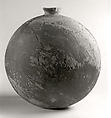Pilgrim flask
Not on view
This lentoid (i.e., lens-shaped) ceramic vessel is made of grey-brown clay and decorated with a plum slip. It has a narrow mouth, and is complete except for part of the rim. It was excavated at Shahr-i Qumis in northern Iran, which has been identified as the ancient city of Hecatompylos, established by the Parthians as the capital of their empire by about 200 B.C. In Greek Hecatompylos means ‘a hundred gates,’ suggesting that the city was quite large. Indeed, the modern archaeological site includes several mounds, only a few of which have been excavated, and a vast area covered with potsherds. This vessel comes from Site VII, a building which may have originally been an elite residence but which was subsequently reused as a funerary structure.
Vessels of this shape are often called ‘pilgrim flasks’ because of their resemblance to the souvenir vessels sold at Christian pilgrimage sites around the Mediterranean, beginning in the late Roman Empire. Yet this shape existed long before the advent of Christianity, so this term is somewhat misleading. The small size and narrow mouth of this vessel certainly lend themselves to its use as personal flask for water or some other drink, much like a modern canteen.
The excavations at Shahr-i Qumis by the British Institute of Persian Studies in 1967 were co-sponsored by the Metropolitan Museum of Art. However, this flask was not discovered until 1971, and it was acquired from the British Institute as a result of the Met’s financial contributions to the Institute’s excavations at Tepe Nush-i Jan, another site in Iran. At the time the Iranian government allowed foreign excavators to keep a portion of the finds, and these excavators in turn would divide their share among the institutions that supported the work.
Due to rights restrictions, this image cannot be enlarged, viewed at full screen, or downloaded.

